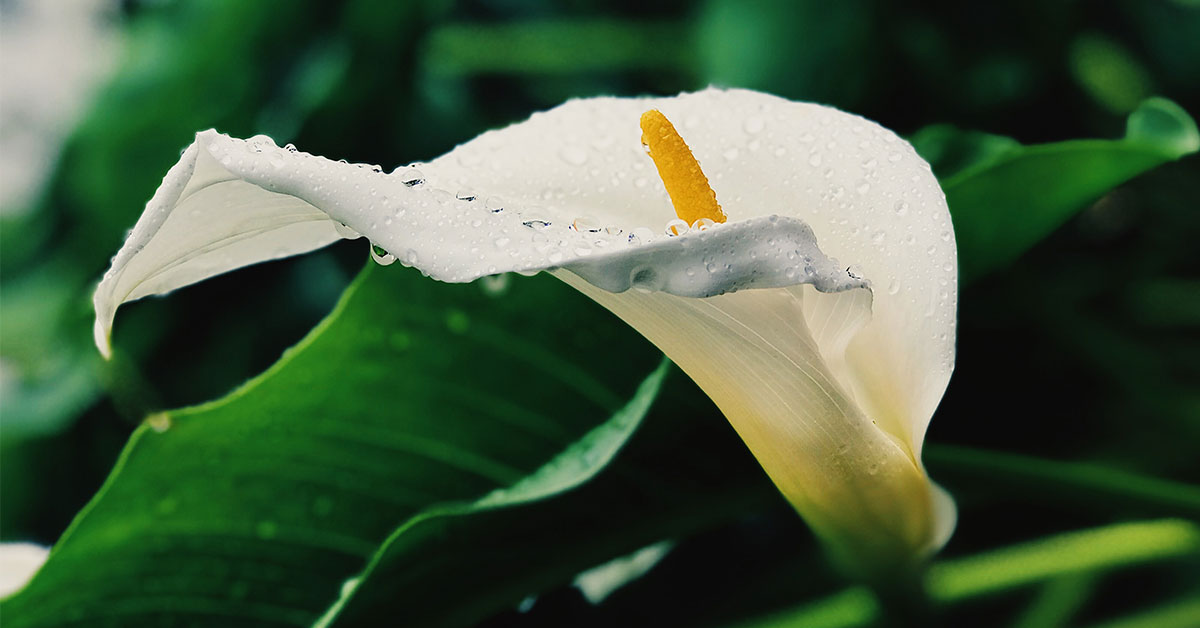A calla lily is a perennial flowering plant with a trumpet-shaped bloom and glossy green leaves. Its bloom has a waxy texture and is typically white or yellow, sometimes with a hint of pink or purple. Known for its long-lasting beauty and its ability to thrive in both sunny and shady conditions, it is a regular household pant. But it can be concerning when you see that your calla lily leaves are turning yellow.
While it is a versatile plant, yellowing leaves mean dying leaves. This can sometimes be explained by the natural life cycle. Calla Lillies grow many leaves quickly. Some of these will naturally die and be replaced with new leaves. If many leaves are turning yellow, then there is something the plant doesn’t like. Most causes of the issue are easily remedied!
Causes of Calla Lily Leaves Turning Yellow
Yellowing and drooping of leaves is called chlorosis and has many causes. It could be anything from pests to environmental issues like soil, water schedule, or light. When yellowing, a Calla Lily will not bloom. Below we will help you diagnose the reason and return your plant to its former glory.
Pests
Snails, caterpillars, and slugs enjoy eating the leaves of Cava Lilies. Their interactions with the plant are easy to track and spot so we’ll start here. Look for grouped-together holes or evidence of a slime trail. If there is evidence of pests attacking your plant, start your flower’s healing process by getting rid of them. You can use pesticides or create barriers to stop them. Using copper tape or vaseline is an effective barrier. You can also use beer or eggshells around your lilies to keep them safe.
Watering
Cava Lillies can wilt with the wrong watering table. Make sure that the pot you are using has adequate drainage holes, and that the pot isn’t sitting in water-logged dishes for an extended time. Many people think you should water the flower once a day. That is a good rule of thumb but may not always be the case. An easy way to tell if you lily wants water is to put your finger in about an inch and feel if the soil has moisture. Water it if it feels dry, and stop for a while if it feels soggy.
Nutrition
If your Cava Lily isn’t getting the right amount of nutrients, it can turn leaves yellow. They should be fertilized regularly with a high-phosphorous fertilizer. You can also add bone meal to the top of the soil every month or so. If this is the issue you should see new growth in a few days.
Sunlight
Cava Lilies do well in partial sun and shade. Too much of one can stress the plant causing the leaves to discolor. These colorful flowers need 4 to 6 hours of sunlight. Gauge what the plant is currently getting and make small adjustments to increase or decrease its daily sunshine.
Your Cava Lily is Entering its Dormant Phase
If all the leaves are turning yellow and dying off in autumn, don’t fret. Cava Lilies go into a dormant phase shortly after flowering. This is normal for this flower cycle. Remove all the discolored leaves and prune the plant to just above the soil line. Store it in a cool, dark, and humid area until spring. Water was very sparingly over this period. The flower doesn’t need much in this state and too much water will cause root rot. Allow the top third of the soil to completely dry out before watering again. Once spring rolls around, relocate it to a bright location without direct sunlight. This is a good time to add some fertilizer.
Disease
Cava Lillies are very susceptible to root rot. If no other apparent reason can be found for its illness then it may be root rot. This is when there is too much water around the roots. this causes them to suffocate and mold. Be wary of over-watering your lily. To discover if this is the issue you will have to carefully dig up your lily and inspect the roots. White roots are healthy and brown/black, slimy roots are rotting.
If the root rot isn’t affecting more than 30-40 percent of the roots you can save it. Rinse off the bulbs and roots. Using a sterile pair of scissors and gently cut off the affected area. Re-pot the plant in a container that has adequate drainage and nitrogen-rich soil. It will take some time for the plant to recover, even simply repotting a healthy Calla Lily can cause the lily to stress and turn yellow.
Removing Yellow Calla Lily Leaves
While yellow Cala Lily leaves can turn green again, it’s good to know how and when to remove them. If the discoloration is extreme or the flower is entering into a dormant state, that’s the time to remove the leaves. You want to remove the leaves to help the plant to conserve its energy. To remove the leaves, use a sterile pair of scissors to cut as close to the base as you can. This will prevent the plant from wasting its energy.
There are times when you can just let the plant repair itself. If the discoloration is sparse and you believe you have found what is stressing your plant out, give the plant a chance to correct on its own. If the conditions worsen you can always prune as need be.













